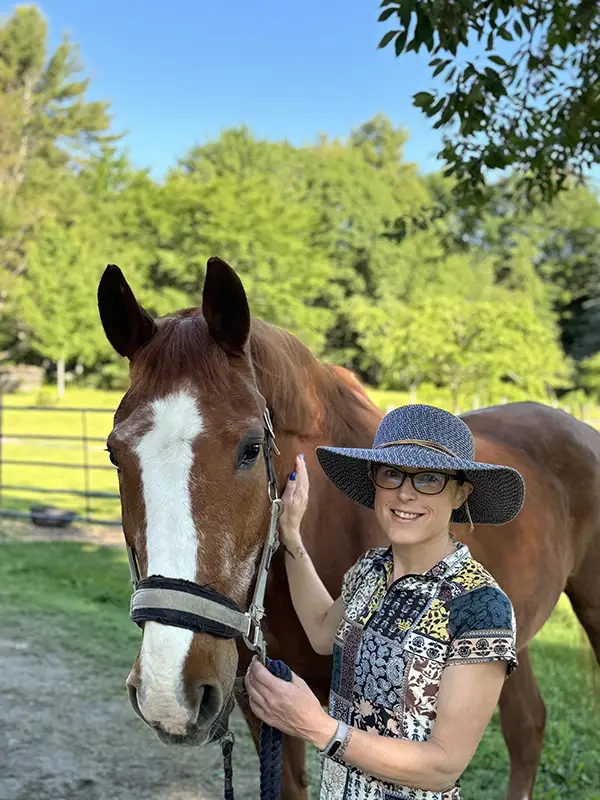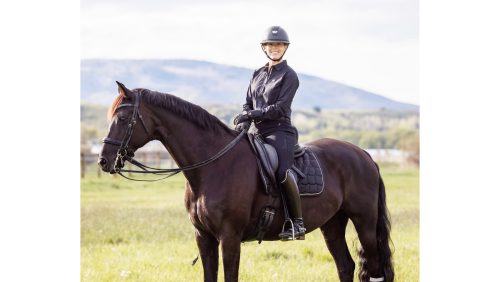Losing a horse is not a new experience around these parts. Whenever one of my fellow authors posts about a loss, I know it is something we can all relate to. While terribly sad, the circle of the equine life is something we can all understand and have empathy for.
Recently, I said goodbye to my longtime friend, and first “real” horse, Baffin. Some of you in New England might feel a tickle in the back of your brain right now and wonder “the same Baffin who was such a hooligan back in the late 90’s??” And yes, indeed, it was him. (And yes indeed, I have enjoyed people reminiscing about the life and time and antics he bought to the dressage scene back in the day!)
I was only 18 when he arrived at my barn, a 3-year-old, New Hampshire-bred Hanoverian who my mother, Linda, thought could be a good horse for my future adult riding career. It was 1998 and I knew next to nothing useful about training (and thankfully knew that, but I was scrappy and sticky—which really paid off in the first few years with him—and had at least figured out a couple things about riding). A tip off to his predominant personality trait, at the time, might have been best expressed by the son of his seller, who shouted “See ya later, you mean old thing!” as we hauled him away in the trailer.
But Baffin was not really mean at all. The biggest problem, as I wrote articulately in my 18-year-old diary, was this:
“Baffin is a really nice horse” I reflected “But here is the tricky thing. He doesn’t really like to be touched. Or even looked at! And I’m not sure he likes people much at all… Not even me.”

Knowing that he had enjoyed the most kind and thoughtful of upbringings, I thought his 3-year-old antics were a bit over the top. And it was 1998, so the world of advanced exploratory vet care was still a ways off. So, mean he was not. But he was certainly cut from a different type of cloth!
Without going into all the details of his youth, I’ll sum it up by saying that “B” was the horse who made me the trainer I am today. I had to think through every training move, and contemplate the best way to present it to him so he felt it was fair and just. He only responded to kindness, so all corrections had to be with the best of intentions. I constantly had to consider what was best for him—and what would make him a better horse for tomorrow. This was a lot to wrap my head around at 18, but this is also when I began working with my longtime trainer, Susanne Hamilton, and she was incredibly supportive of the sometimes unique path we had to take to teach him things.
ADVERTISEMENT
My willingness to listen to his needs slowly developed the trust between us, and over time he became a horse who would walk through fire for you. Now don’t get me wrong, he still tried to kill the veterinarian until he was about 18 (the stabby needles were not good, fair or fun in his opinion), but despite his suspicious nature, he became an absolute steadfast rockstar to ride. At this point, he had also decided that he liked me and trusted me. Also, he was undeniably fond of my mother, who helped me coax him into becoming a good boy. She could talk him into many things with bribes and apple slices and patience.
He was my first FEI horse (the hoops we had to jump through to teach him both pirouettes and flying changes gave me the tools to solve almost any future problem). Despite the fact that his canter was never remarkable, he was incredibly reliable in the show ring, and almost always in the ribbons. He was just a joy to compete—never the most gifted horse, but always willing to give 110% to me as soon as we went down the centerline. (Although throughout his life, if he felt peeved at home, he would still become offended by being touched or looked at!)
We managed to coax just enough piaffe and passage out of him to compete a couple adequate Intermediaire II tests. (Talk to me sometime about the persuasion required to teach these movements to him!) While Grand Prix was almost within reach, I did not think it was fair to him to push him beyond his capability. After so many years of developing trust and partnership, I wasn’t willing to ever risk that by pushing him unfairly.
When he was 18, and I was in my 30s, I pondered what to do next. He was not ready for retirement, but needed a lighter workload. I was absolutely not going to sell him, because I couldn’t trust strangers to do things the way Baffin demanded. Luckily for both of them, my student Casey needed a horse to ride and B accepted her and gracefully allowed her to take the reins.
This was an amazing time for the three of us, as Casey and Baffin got on like peas and carrots! I would pat him before they would go into the show arena and say “take care of her,” and he understood the assignment.
Throughout his older years, it was never about the ribbons or prizes, but always about allowing him to do what made him happiest. I know some will argue “no horse is happy with the stress of competition,” but what can I say? B was an exception to this. And the day he returned from a show when he was 22, looked at us, and we saw a tired horse, we never asked him to compete again.
He went on to enjoy helping another student of mine to learn the ropes of training level at home, he delighted in spending time hassling his pony, Pepper, and bossing her around. He would occasionally still try to bite us, just for the entertainment of watching us jump. He had myriad old-horse problems, but we could manage them well. When he was 26—and somehow I was in my 40s—he went into full retirement to live out his years being groomed, spoiled, medicated and to just enjoy life.
ADVERTISEMENT

Since the day I got him, I hoped he could live his life and never have a bad day. I hoped he would be healthy, and discover that the world was kind and that he was cared for. As I watched him in the last years of his life, I felt content that I had succeeded. He was happy and healthy, I had never put my ego or needs over his care, I had always made the choice to stop one day early rather than one day late. And as horses age, if you want them to continue living that way, you need to decide what the end game is.
Over the course of this spring not only had B lost some mobility, his Cushings disease also was taking a toll. I could not imagine finding him down, unable to get up, so I knew the time had come to make a difficult but responsible choice.
On a beautiful June day this year, after a couple of weeks of being entirely spoiled by friends and family, we said goodbye to my good old friend. Thankfully, and in the same attitude that I had kept throughout his life, it was not one day late. He never knew a bad day.
I am celebrating a life well-lived, and the fact that he touched the lives of many people. I am profoundly thankful for the things he taught me—it is always the tough horses that help you to learn who you want to become. I am thankful I was able to give him a dignified and thoughtful exit, which is truly the biggest kindness we can give an animal who is family.
And in typical Baffin fashion, even in his final moments he did low-key try to kill the vet. Some things just never change!
I’m Sara Bradley, a full-time dressage trainer and rider. Most of my time is spent educating a delightful variety of horses and riders at my facility, Waterford Equestrian Center in Waterford, Maine.
When I’m not busy juggling the day-to-day activities at my farm, I enjoy activities like trail running over actual mountains and running marathons. (Life in the slow lane is not my style!) I enjoy many dressage adventures with my German Riding Pony, Dubai’s Dream, and you can follow this journey on Instagram @dubais_dream.














